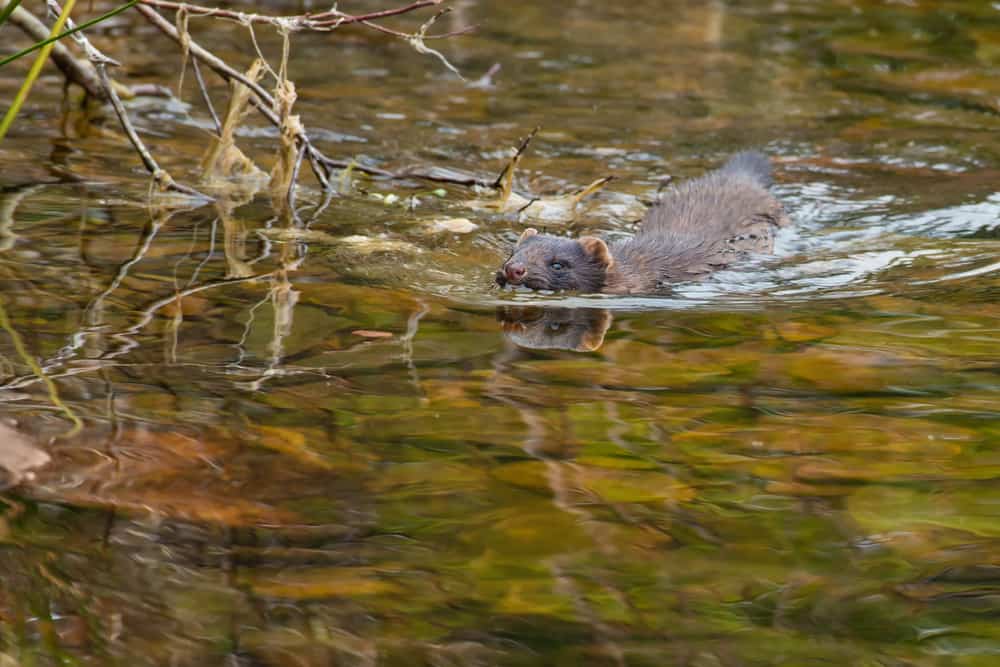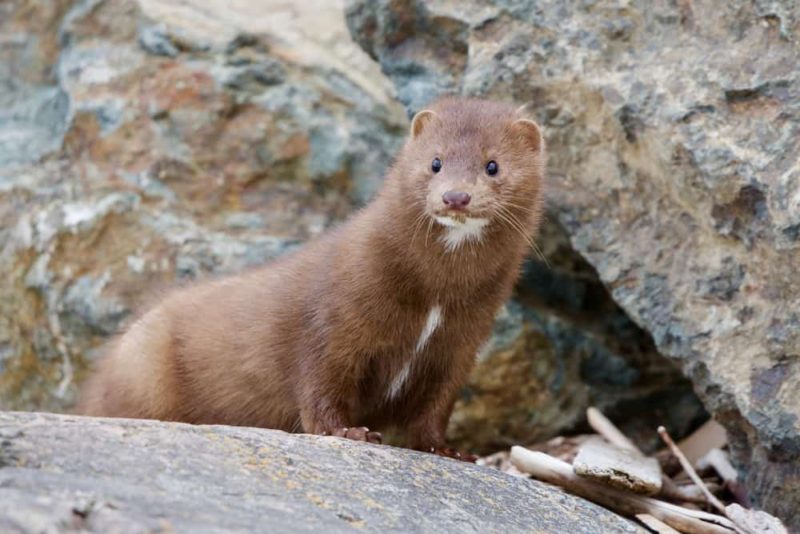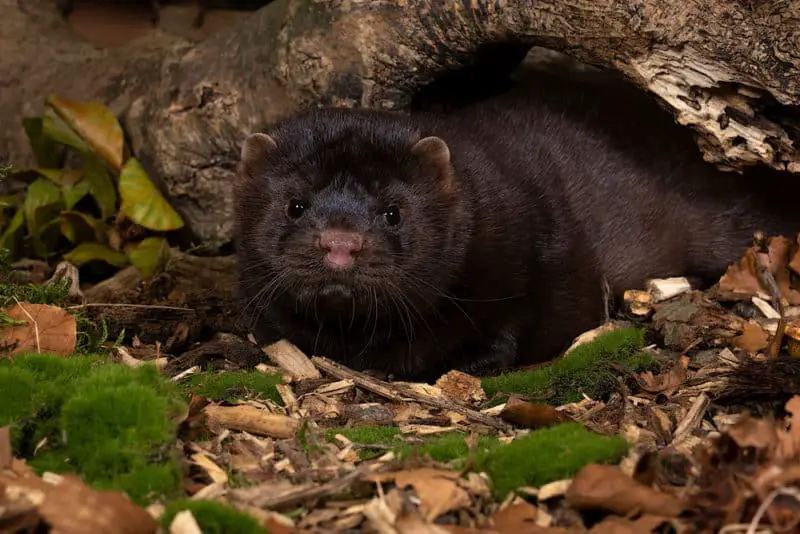There are two different types of minks: the American mink and the European mink. A third species is called the sea mink, but it sadly went extinct in the 1860s. Minks are very small, discreet, and often nocturnal. Because of their small, narrow bodies, pointed snouts, claws, and soft fur, minks are related to otters, polecats, weasels, and ferrets. This article is solely revolved around and all about the adorable semiaquatic minks, aside from distinguishing between minks and otters.
Do Minks Live in the Water?
Minks do not live in water but are rarely found away from a water source. They usually make their homes around the shore of a water source such as a lake, pond, stream, or river. Minks make their dens or homes by digging holes near trees and living in tree roots or hollowed-out logs.
Whether the mink makes its home by digging or finding a hollowed-out log, it usually takes grass, leaves, or even fur from its prey to make the home or den more comfortable. Minks rarely stay in the same place for too long, and they constantly change their homes’ location.
Is That a Mink or an Otter?
If you see an animal near or in the water, it is more likely to be either a mink or an otter. Knowing the difference between the two is pretty simple. The differences include:
- Otters have flattened tails, while minks have furry and round tales.
- Otters are fairly bigger than minks. Minks are usually smaller or around the size of a domestic cat, while otters are bigger and resemble a medium-sized dog’s size.
- Notice the animal’s position in the water. Otters usually swim with only their head and a tad bit of their tail visible, while minks swim with most of their bodies outside of the water.
- Look at the color of the animal; if the coat is a light to medium brown, it is most likely an otter, but if the color is a dark brown to black, it is most likely a mink.
From a distance, otters and minks can look about the same, but it is simpler to distinguish the differences between the two when you take a closer look.

Are Minks Good Swimmers?
Minks have fur that is somewhat water-repellent, and their undercoat naturally grows thicker in the colder winter months to provide warmth. Minks may not be as good as otters at swimming, but they are also pretty good in the water. Their feet are partially webbed, so they can swim better by paddling the water with their feet. Minks can even dive deeper into the water, up to 16 feet deep.
Can You Find Minks Together in Groups?
Minks are usually by themselves because they are very territorial unless it is mating season. Minks spend most of their time being active, marking their territory, and hunting for their meals by themselves around dawn and dusk hours. Male minks usually scale a bigger territory than female minks.
During the breeding or mating season, usually beginning between January and March, the minks can often be found in pairs or family groups with their young minks. During this season, minks often share homes with their mates and babies until the kits are around eight weeks old.
Minks are born like kittens, helpless and blind, so they need their parent minks to survive at a young age. By the end of the summer, the young minks usually go off to find their own territories, homes, or dens.
How Long Can Minks Stay Underwater?
Minks can swim up to 50-100 feet under the water while only able to scale a shorter distance than that while swimming on the water’s surface. Although minks do not often dive, when studied, it was found that minks can dive consecutively for up to around 36 minutes, briefly taking intervals for a couple of minutes.
Do Minks Hunt in the Water?
Minks hunt for their food both on land and in the water. On dry land, they hunt earthworms, rabbits, rats, chipmunks, grubs, muskrats, and mice. Hunting fish, frogs, ducks, eggs, crabs, clams, crayfish, and lizards in or around the water’s edge. Minks are usually seen in the water hunting prey in the warmer months of the year, while in the winter, they hunt prey on the land. Sometimes, minks move closer to farms or man-made ponds to easily find their next meal.
Minks moving towards farms threaten livestock such as chickens, eggs, hens, roosters, or other small livestock. Minks are aggressive and usually hunt whatever they can, sometimes killing a yard full of chickens just to kill them. Some European minks have been spotted eating vegetation around or near rivers, ponds, streams, or lakes.
Are Minks Dangerous Towards Humans?
Minks can bite, scratch, claw, make a raspy bark and even spray like a skunk when they feel threatened, but they can also purr like a cat when they are happy and content. Minks have six main predators: bobcats, foxes, wolves, coyotes, owls, and humans. Minks are aggressive, and if you approach them, they will feel threatened and begin defending themselves, even if they are hurt or sick. If you find and want to help a hurt or injured mink, you should call your local wildlife clinic, a rehabilitation center, or someone who will know who to call. Calling a pest control or animal shelter could potentially result in the mink dying.
Do Minks Make Good Pets?
Minks resemble domesticated ferrets; for this reason, many people believe that minks could make good house pets. That is not the case; minks might be less stinky and around the same size as a ferret, but they are highly aggressive. With time, patience, and the mink’s personality, and depending on the age the mink is when you get them, you may be able to bond with a mink making them less of a threat to you.

Minks are not suitable pets for reasons such as:
- Attacking Other Pets: A mink has killer instincts and will attack your cats, dogs, fish, rabbits, ferrets, other minks, or any other pet you may have.
- A Danger to Children and Strangers: If you have children, they will obviously want to play with the mink because it is so cute, or your friend may want to touch or play with it. When a mink bites, it tends not to want to let go. It can easily bite so deep that it goes to the bone.
- Escape Artists: Minks are very clever animals. They are known to be escape artists. If you do get a mink, you must ensure its cage is properly secure in all areas, or the mink will find the weak spot and escape.
- Habitat: Mink’s natural habitat is by a water source such as a pond, lake, stream, river, and other larger bodies of water. Their usual day consists of them hunting, marking their territory, swimming, and sleeping. They can not perform normal daily activities while locked in a cage and may become more aggressive and unhappy.
If you do happen to obtain a mink as a pet, please keep all of these reasons in mind. Check with your local laws to find out if owning a mink is legal. Mink farms are everywhere with the main goal of harvesting their fur, but just because they made it legal for the farm to own minks to breed and kill, that doesn’t mean they are legal for house pets.
Are Minks In Danger of Going Extinct?
Unfortunately, American minks have been bred for many years because of the high demand for their fur to make clothing and other accessories for humans. Sometime in the 1900s, they took American minks into European areas for mink farms to breed and get their fur. The American minks have made their way out into the wild in European areas and endangered the European minks. American minks are not currently endangered, but the European minks are competing with American minks, mink hunting and destruction of their habitats.
Overall, minks are beautiful and interesting to learn about. Here is a quick review of the facts you have learned by reading this article:
- Minks do not live in the water; they live around the water in holes, roots, and hollowed logs.
- Minks are excellent swimmers because their feet are webbed and made for swimming, and their fur naturally has a water-resistant type of oil on it.
- Minks are loners and usually only travel in groups during mating season.
- Minks are carnivores, aggressive, and like to hunt. They will even attack and kill animals that are larger than them.
- Minks can be dangerous to humans because they view us as predators and are more likely to attack. You shouldn’t approach a mink in the wild, even if they are hurt or sick. Instead, call someone to help the mink.
- Although you may be able to legally own a mink as a pet, you might want to consider why you shouldn’t.
- American minks are not currently endangered, but European ones are currently endangered.
Sources:
https://www.livescience.com/56071-mink-facts.html
https://www.britannica.com/animal/mink
https://animals.mom.com/identify-otters-minks-1274.html
https://scottishwildlifetrust.org.uk/2013/09/mink-or-otter/
https://www.burlingtonfreepress.com/story/news/2017/01/21/minks-good-swimmers-land-hunters/96860054/
https://www.havahart.com/minks-facts
https://www.esf.edu/aec/adks/mammals/mink.htm
https://thenorfolkminkproject.org.uk/mink-biology/
http://wildliferesponse.org/component/content/article?id=56:mink-and-weasel-family
https://www.dnr.state.mn.us/mammals/mink.html
https://vetmed.illinois.edu/wildlife/wildlife-help-and-resources/weasels-and-minks/
https://www.sciencedaily.com/releases/2015/09/150922114944.htm
https://pethelpful.com/exotic-pets/domesticated-mink
Recent Posts
The only venomous snakes in Washington State are Northern Pacific Rattlesnakes. The Northern Pacific Rattlesnake (Crotalus oreganus oreganus) is a sub-species of the Western Rattlesnake. Anyone...
Skunks are not classified as true hibernators. But they go into a state of torpor when the weather gets cold. Skunks are light sleep hibernators, along with opossums, bears, and raccoons. ...

